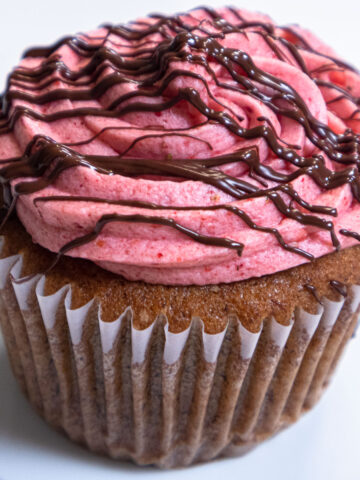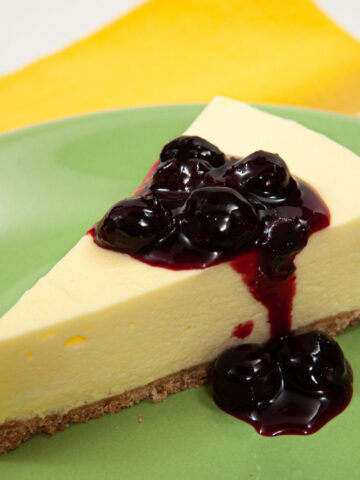
A show stopping Triple Lemon Cake will have everyone asking where you got it. Watch their reaction when you tell them you made it! It's the perfect spring cake.
This cake contradicts the normal assembly of a cake. The “filling” is on the outside of the French sponge cake, genoise. The crumbs on the outside are cake crumbled in the processor. To protect the “filling” from crusting over, meringue is piped on top.
To make things easier it consists of easy component parts that can be made ahead and assembled when needed.
Genoise
While originating around 1500 in Genoa, Italy, the French named it genoise when they took it over. French baking borrowed recipes liberally from other nations, renaming them as they went along. Genoise has a reputation for being two things - difficult to make and dry.
Used as a foil for many fillings and finishes, the cake is a type of butter sponge in which whole eggs are beaten with sugar to incorporate air. This is the only leavening in the cake. Processing granulated sugar will turn it into bakers sugar which is very fine, allowing it to become incorporated with the eggs much easier, better and faster. The eggs should be room temperature. If you forget to take them out ahead of time, just put them in hot water while you get everything else ready.
The genoise layer can be made months ahead, frozen, wrapped really well and held in the freezer awaiting the final assembly.
The cake can be dry and dense if the flour is folded in too forcefully or too long. Sift the first half of the flour over the egg mixture and fold it in about ¾ of the way. Repeat with the second half. A very light touch is needed here. Emulsify the butter and fold it in.
Emulsifying the Butter
When I wrote my first book, The New Pastry Cook, I struggled mightily with getting the melted butter folded into the batter. Despite having a wonderful French pastry chef instruct me, my butter always ended up on the bottom of the baked cake, making a rubbery, dense, unattractive and unwanted layer.
What I ended up doing was whisking some of the completed batter into the butter. By whisking vigorously, it became emulsified. The butter becomes suspended in the batter and is no longer liquid. That was added back to the majority of the batter and quickly folded in which solved the main reason this cake was thought to be difficult.
If you think about it, it is so much easier to beat whole eggs than whipping egg whites and yolks separately, then folding in together with the flour. The chances of knocking the air out of them is much higher than with genoise.
Lemon Soaking Syrup for the Triple Lemon Cake
There are several reasons for using a soaking syrup. The most important is to add flavor, either to intensify the main flavor or to add another dimension. The second reason is to add moisture.
It is added to this Triple Lemon Cake to maximize the lemon flavor.
The “Lemon Filling”
If you love lemon meringue pie, you will love this “filling”. The lemon is intense but not biting. It is added as the top layer of the cake and on the sides as the glue to keep the crumbs in place.
The filling needs to be refrigerated, preferably overnight to firm up before it can be used.
Cake Crumbs for the Finish
Using cake crumbs to finish the outside of a cake is a very “bakery” thing to do. Especially, since there are often cake trims or leftover cake around. Simply tear the cake into pieces and add them to the processor. Pulse to make crumbs.
This works for any plain cake. If not needed immediately, store the crumbs in the freezer for later.
Swiss Meringue for the Triple Lemon Cake
While there are three basic types of meringues, I chose the Swiss meringue for this cake because I wanted a denser meringue – sort of marshmallowy.
The egg whites and sugar are heated together in the mixing bowl and then whipped to hold stiff peaks. Piping or spooning them over the exposed lemon “filling” will prevent it from crusting over.
Fresh Fruit
One of my readers Liza had a great idea. If you don't want to go the Meringue route, use fresh berries. Blueberries or raspberries would be perfect because of their size.
Triple Lemon Cake
Ingredients
Genoise Cake
- 6 eggs, room temperature
- ¾ cup granulated sugar (150 grams or 5 ⅓ ounces)
- Zest from 1 large lemon
- 1 ¼ cups cake flour* (155 grams or a scant 5 ½ ounces)
- ¼ cup unsalted butter (60 grams, 2 ounces, ½ stick)
- *All-purpose flour can be used by weighing the same amount flour and removing 2 tablespoons.
Lemon Filling
- ⅔ cup water
- ⅔ cup granulated sugar (130 grams or 4 ½ ounces)
- 2 large eggs, separated
- 3 tablespoons cornstarch (25 grams or 1 scant ounce)
- ¼ cup lemon juice
- 1 teaspoon lemon zest
- ¼ teaspoon salt
- 2 tablespoons butter
Lemon Soaking Syrup
- ½ cup lemon juice
- 1 cup sugar (200 grams or 7 ounces)
- Meringue
- 2 egg whites from above
- ½ cup sugar (100 grams or 3 ½ ounces)
Instructions
Genoise
- Preheat the oven to 350°F. Line the bottom of a 9x3” cheesecake or springform pan with parchment.
- Spray the middle of the paper only. Do not spray the sides. Set aside.
- Melt the butter and set aside to cool.
- Add the eggs, sugar and lemon zest to the mixing bowl. Beat until very, very thick , almost white and the mixture falls in ribbons from the beater.
- Sift half the flour over the egg mixture and fold in about ¾ of the way. Repeat with the remainder of the flour.
- Add about 1 cup of the batter to the melted butter. Whisk vigorously to form an emulsion.
- Pour the emulsion back into the main batter and fold in.
- Pour the batter into the prepared pan, smoothing as necessary.
- Bake for about 23 to 28 minutes until a tester comes out cleanly and the cake bounces back when lightly touched in the middle.
- Cool completely in the pan.
- To release, go around the inside edge with a small, flexible metal spatula. Make sure the spatula stays to the side of the pan and not the side of the cake.
- Remove the side. Turn the cake upside down, remove the bottom and the parchment paper.
- Turn right side up. If not using immediately, freeze the cake, wrap it well and then freeze for several months. Partially thaw at room temperature to use.
Lemon "Filling"
- In a medium saucepan, whisk together the water, sugar, egg yolks, cornstarch, lemon juice, lemon zest and salt.
- Place over medium heat and, whisking constantly, bring the mixture to a boil. Boil for one minute. It will be very, very thick. Remove from the heat.
- Add the butter and allow to melt. Whisk into the mixture. Remove to a bowl
- Cover the “filling” with plastic wrap and chill, preferably overnight.
Lemon Soaking Syrup
- Combine the ingredients in a small pan and bring to a boil. Set aside.
Triple Lemon Cake Assembly
- If the genoise layer has been frozen, thaw it at room temperature until it is partially thawed but still firm. This will make it easier to cut.
- Slice about ⅛” off the top of the cake.
- Place in the processor. Pulse to make crumbs. Set aside.
- Put the cake back on the metal round from the cheesecake or springform pan.
- Brush the soaking syrup on the cake, allowing each pass to soak in before adding more. Use all the syrup.
- Break up the “filling” with a spatula. Aggressively whisk it until smooth.
- Apply a thin layer to the sides of the cake, making sure all of it is covered. Spread the remainder on top of the cake.
- Pick the cake up in your left or right hand whichever is your preference. Scoop up some of the crumbs and press them lightly into the lemon.
- Drop the remainder of the crumbs about an inch in from the edge of the cake.
Meringue
- Place the whites and sugar in a mixing bowl. Put the bowl over a pan of simmering water.
- Heat to about 130°F.
- Remove from over the water and place on the mixer fitted with a whisk attachment.
- Beat until stiff and glossy.
- Place in a piping bag fitted with a large open star (#8 or 9 B tip) and pipe the meringue onto the lemon filling starting at the edge of the crumbs and work towards the center. I simply piped straight down and immediately piped again.
- Alternatively, the meringue can be spooned on.
- Fill in completely to cover the “filling” so it can’t crust over.
- Refrigerate.













Mark Mayer says
A few years back on my annual visit to family in Italy, I committed the grave error of saying my favorite desserts were French morning pastries and German/American butter cakes. Italian cakes are almost always made of genoise and then soaked. Everything but the kitchen sink ( cream, alcohol, chocolate) often appear. The cake component becomes an afterthought. This cake in its simplicity and visual appeal is a show stopper. If it were not for this recipe and one other I have for an amazingly not dry chocolate genoise, I’d be through with spongey cakes. Oh… forgot that I married a genoise eater. Enjoy this cake in all its lemony splendor!
Helen S Fletcher says
Hi Mark - I agree that sponge and genoise can be quite dry which is why they are soaked. Although I often soak all kinds of cakes but to add additional flavor and dimension. Lemon is a favorite flavor of mine and this recipe has that in spades. Good to hear from you.
jkharnagel says
Helen, though this is a beautiful cake and I LOVE lemon desserts, I prefer pie. Would this filling be a good choice for a lemon meringue pie? Also, the description of marshmellowy texture on the meringue has me craving it. Is Swiss meringue a good choice for topping a pie?
Helen S Fletcher says
If you go here there is a great lemon pie on my blog. This meringue would work but it is not as fluffy or as much as the one included in the pie recipe. However, if you triple the Swiss meringue used for the cake, you should have enough to cover the pie.
Cindy says
Can you toast the merengue or will it change the overall flavor?
Helen S Fletcher says
Hi Cindy, it will change the taste of the meringue but not greatly. The biggest thing is not to burn the crumbs surrounding it.
Liza says
YUM! Instead of the meringue could you just add raspberries or blueberries?
Helen S Fletcher says
Hi Liza - What a great idea! Absolutely, Yes! I'm going to include it in my blog.